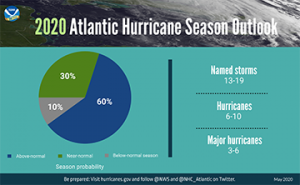 The Atlantic Hurricane Season runs June 1st through November 30th. Researchers have estimated 6-10 hurricanes predicted during the 2020 season – up to 6 major; with 13 total named storms. Ever wonder where the names for tropical storms and hurricanes come from? And why are they even named in the first place?
The Atlantic Hurricane Season runs June 1st through November 30th. Researchers have estimated 6-10 hurricanes predicted during the 2020 season – up to 6 major; with 13 total named storms. Ever wonder where the names for tropical storms and hurricanes come from? And why are they even named in the first place?
Prior to the 1950s, hurricanes and tropical storms were tracked by using the year and the storm’s order in that year. For example, the third tropical storm in 1920 would simply be referred to as “1920 Storm 3”. During the 1950s, meteorologists were having difficulty tracking storms in this fashion and started using names for the storms.
Today, the World Meteorological Organization is responsible for developing the names for both Northern Pacific and Atlantic storms. They use six lists of names for each, rotating them each year. Names of storms which have done tremendous damage such as Katrina, Michael, Sandy, and Harvey, have been retired from the lists and replaced with another name starting with the same letter. More than 80 names have been retired. Not all letters of the alphabet are created equal! Q, U, X, Y and Z have been omitted, leaving only 21 names on each list. And if there are more than 21 storms? Additional storms will take names from the Greek alphabet.
2020 so far:
- Arthur – Tropical Storm, May 18th, North Carolina
- Bertha – Tropical Storm, May 27th, South Carolina
- Cristobal – Tropical Storm, June 7th, Louisiana
- Dolly – Tropical Storm, June 23rd, NE US Coast (never landed)
- Edouard – Tropical Storm, July 6, New Foundland
- Fay – Tropical Storm, July 10th, New Jersey
Next 5 names:
- Gonzalo
- Hanna
- Isaias
- Josephine
- Kyle
For the full list, visit the National Hurricane Center. While there, revisit some of the preparations you should take during this hurricane season.
AFTER SURVIVING THE STORM… THE BATTLE MAY NOT BE OVER.
MOLD
Mold can cause serious health problems. The key to mold control is moisture control. After the flood, remove standing water and dry indoor areas. Remove and discard anything that has been wet for more than 24-48 hours.
The EPA guide for building managers, custodians, and others who are responsible for building maintenance: EPA-Mold
RENOVATION AND REBUILDING
Once the mold is remediated, it’s time to rebuild! But wait, there are regulations related to build back activities. Two to keep in mind:
Lead-safe work: By law, contractors need to use lead-safe work practices on emergency renovations on homes or buildings built before 1978. Activities such as sanding, cutting, and demolition can create lead-based paint hazards. Lead-contaminated dust is harmful to adults, particularly pregnant women, and children.
Asbestos: Anyone working on demolition, removal, and cleanup of building debris needs be aware of any asbestos and to handle asbestos materials properly. People exposed to asbestos dust can develop serious lung health problems including asbestosis, lung cancer and mesothelioma. Although the use of asbestos has dramatically decreased in recent years, it is still found in many residential and commercial buildings and can pose a serious health risk.
If your organization is affected by a storm and you do not know where to start… CALL ERC!
We offer turnkey services that can get you back up and running as quickly as possible. For those participating in TIPS or Choice Partners cooperatives, ERC holds disaster mitigation contracts designed specifically for this type of recovery.
